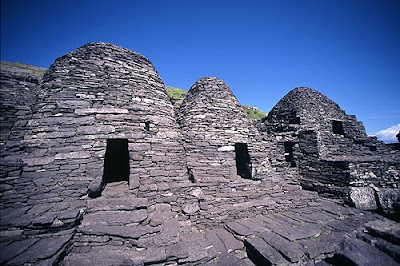
Skellig Michael (Sceilig Mhichil), or Great Skellig, is the larger of a pair of forbidding limestone pinnacles—the other is Small Skellig—jutting from the Atlantic Ocean about 7 miles (12 kilometers) off the Valentia peninsula at the southwest tip of Ireland. Skellig Michael, only 44 acres (17 hectares) in area, is dominated by two crags, one of 712 feet (218 meters) and another of 597 feet (183 meters). On top of the latter, reached via steep, winding stairways cut from the rock, there is an artificial platform with a cluster of six circular drystone huts (clochans), two boat-shaped oratories, some stone crosses, and a cemetery—all that remains of a monastery established, possibly by St. Fionán, sometime in the sixth century a.d. and called “the most westerly of Christ’s fortresses in the Western world.” This monastic foundation on Skellig Michael was one of many in which the Christian tradition was preserved as the rest of western Europe was plunged into a dark age. As the art historian Kenneth Clark once put it, European civilization escaped by the skin of its teeth.
Moreover, the island’s remarkable architecture, although small, was an achievement of inventiveness and effort seldom seen in history.
In the sixth century, just as the monastery was being established, St. Columbanus described the Irish as people “living on the edge of the world.” Hermits who chose to settle on such islands as Skellig Michael subjected themselves to long periods of total isolation, while through lives of prayer and contemplation they searched in silence and solitude for God. In winter Skellig Michael was, and still is, completely inaccessible. Paradoxically, monasticism was the vehicle for the eastward spread of Celtic Christianity. It was established in Scotland and the north of England by Columba, Ninian, Wilfrid, and Aidan.
The platform was reached by any of three zigzagging stairways—one with 670 steps—from different points at the base of the island. The monks built them by carving the rock and by carrying and placing thousands of flat stones. The terracing at the top was achieved, probably over decades, by constructing massive drystone retaining walls and filling behind them. On these level places the reclusive churchmen built their huts, using a flat-stone, corbeled technique already thousands of years old. The successive courses of the circular buildings, laid without mortar and with outward-sloping joints to drain the rainwater, gradually diminished in diameter, closing the building to form a pointed dome—a “beehive” dome. The 6-foot-thick (almost 2-meter) walls and roof were thus integrated into a single entity, providing living quarters and storage. The monks grew vegetables, probably in soil imported from the mainland, supplemented by a diet of seabirds, gulls’ eggs, and fish. They traded eggs, feathers, and seal meat with passing boats for grain, tools, and animal skins, from which they made vellum.
Vikings plundered the Skellig Michael settlement four times between 812 and 839 but the little community survived. Some rebuilding took place in I860, and it is likely that many of the surviving buildings on the island are from that period. Around 1000 the chapel was added to the monastery, using stone from nearby Valentia Island. Sometime in the twelfth century, the monks withdrew to the Augustinian priory at Ballinskelligs on the mainland. Skellig Michael became and remains a pilgrimage site. In the nineteenth century, two lighthouses were built on it, one of which remains functional. From 1986 the Irish Office of Public Works carried out restoration of the Skellig monastic site, and the buildings were added to UNESCO’s World Heritage List in 1996.
No comments:
Post a Comment